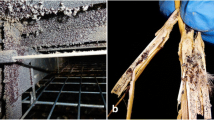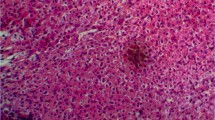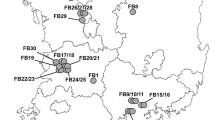Abstract
Mites are considered a threat to the commercial poultry industry due to their direct and indirect pathogenic effects. Dermanyssus gallinae is among the mite species that endanger production, as it is hematophagous and poses a serious sanitary risk. Recently, Tyrophagus putrescentiae has also drawn attention as a potential pest in the poultry industry, and its attacks have been related to clinical symptoms such as cutaneous eruptions and bird restlessness. Considering the potential economic, sanitary, and productive losses both species represent to the laying-hen industry, the aim of the present study was to evaluate the influence of D. gallinae and T. putrescentiae on the health and productivity of commercial laying hens by carrying out infestation experiments and by monitoring laying hens for a period of 60 days. Tyrophagus putrescentiae and D. gallinae affected egg quality and zootechnical parameters in laying hens. Hens infested by T. putrescentiae had behavioral changes, weight loss, stress symptoms, and decreased egg laying and quality, as well as diarrhea, gradual feather loss, and itching. Hens infested by D. gallinae also had weight loss, behavioral changes, and stress symptoms, leading to decreased laying and egg quality. The present study proposes an experimental model to understand the impacts caused by T. putrescentiae and D. gallinae on commercial laying production and egg quality parameters.










Similar content being viewed by others
Data availability
All data and materials are available for publication.
Code availability
Not applicable.
References
ABPA – Associação brasileira de proteína animal (2021) Relatório Anual – 2021. Accessed 20 July 2021. https://abpa-br.org/wp-content/uploads/2021/04/ABPA_Relatorio_Anual_2021_web.pdf
Akbayev RM, Belous AS, Trubnikova EV, Bogdanova ES, Belyakova AV, Epova EY, Shevelev AB (2020) Impact of poultry red mite (Dermanyssus Gallinae) infestation on blood parameters of laying hens. Bionanoscience. https://doi.org/10.1007/s12668-019-00705-0
Al-Saffar TM, Al-Mawla ED (2008) Some hematological changes in the chickens infected with ectoparasites in Mosul. Iraqi J Agricultural Sci 22:95–100
Alves SP, Silva IJOD, Piedade SMDS (2007) Avaliação do bem-estar de aves poedeiras comerciais: efeitos do sistema de criação e do ambiente bioclimático sobre o desempenho das aves e a qualidade de ovos. Revista Brasileira De Zootecnia 36:1388–1394. https://doi.org/10.1590/S1516-35982007000600023
Amaral GF, Guimarães DD, Nascimento JCDOF, Custodio S (2016) Avicultura de postura: estrutura da cadeia produtiva, panorama do setor no Brasil e no mundo e o apoio do BNDES. Accessed 28 July 2021. https://web.bndes.gov.br/bib/jspui/bitstream/1408/9579/3/BS%2043%20Avicultura%20de%20postura_estrutura%20da%20cadeia%20produtiva_corrigido_P_BD.pdf
Ayres M, Ayres Junior M, Ayres DL, Santos ADAD (2007) BioEstat: aplicações estatísticas nas áreas das ciências biomédicas. Ong Mamiraua, Belém, PA
Barros CSL, Santos RL, Alessi AC (2016) Patologia Veterinária. Editora Roca, São Paulo
Bates D, Maechler M, Bolker B, Walker S (2015) lme4: Linear mixed-effects models using Eigen and S4. Retrieved from http://cran.r-project.org/package=lme4 Accessed 02 June 2021
Borne PM, Comte S (2003) Vacinas E Vacinação na produção avícola. Gessulli Guias, Porto Feliz, São Paulo
Bounous DI, Stedman NL (2000) Normal avian hematology: chicken and turkey. In: Feldman BF, Zinkl JG, Jain NC (eds) Schalm’s veterinary hematology. Scientific Research Publishing, Wuhan, pp 1147–1154
Capitelli R, Crosta L (2013) Overview of psittacine blood analysis and comparative retrospective study of clinical diagnosis, hematology and blood chemistry in selected psittacine species. Veterinary Clinics: Exotic Animal Practice 16:71–120
Cardoso ALSP, Tessari ENC (2003) Estudo dos parâmetros hematológicos em frangos de corte. Arquivos do Instituto Biológico 70:419
Champely S (2020) pwr: Basic functions for power analysis. Retrieved from http://cran.r-project.org/package=pwr Accessed 02 June 2021
Chauve C (1998) The poultry red mite Dermanyssus Gallinae (De Geer, 1778): current situation and future prospects for control. Vet Parasitol 79:239–245. https://doi.org/10.1016/s0304-4017(98)00167-8
Chirico J, Eriksson H, Fossum O, Jansson D (2003) The poultry red mite, Dermanyssus Gallinae, a potential vector of Erysipelothrix rhusiopathiae causing Erysipelas in hens. Med Veterinary Entomol 17:232–234. https://doi.org/10.1046/j.1365-2915.2003.00428.x
Colloff MJ (2009) Dust mite allergens. Dust mites. Springer, Dordrecht, pp 273–328. https://doi.org/10.1007/978-90-481-2224-0
Cunha LM, Cunha MM, Leite RC, Silva IJ, Oliveira PR (2009) Comparação Da eficiência de diferentes armadilhas utilizadas para a captura de Dermanyssus gallinae (Acari: Dermanyssidae) (De Geer, 1778). Revista Brasileira De Parasitologia Veterinária 18:59–62. https://doi.org/10.4322/rbpv.01804011
Da Silva GL, Ferla NJ, Toldi M, Faleiro DCC (2013) Mite fauna (Acari) associated to commercial laying hens and bird nests in Vale do Taquari, Rio Grande do sul, Brazil. Biotemas 26:253–262. https://doi.org/10.5007/2175-7925.2013v26n4p2
Da Silva GL, Ohlweiler LM, Schussler M, Pavan AM, Ferla NJ, Silva FR, Johann L (2021) Case report: Tyrophagus putrescentiae (Acari) attacking laying birds in conventional poultry houses. Vet Res Commun 45:1–4. https://doi.org/10.1007/s11259-021-09793-4
Di Palma A, Giangaspero A, Cafiero MA, Germinara GS (2012) A gallery of the key characters to ease identification of Dermanyssus gallinae (Acari: Gamasida: Dermanyssidae) and allow differentiation from Ornithonyssus Sylviarum (Acari: Gamasida: Macronyssidae). Parasites & Vectors 5:1–10. https://doi.org/10.1186/1756-3305-5-104
Dormann CF, Elith J, Bacher S, Buchmann C, Carl G, Carré G, Marquéz JRG, Gruber B, Lafourcade B, Leitão PJ, Münkemüller T (2013) Collinearity: a review of methods to deal with it and a simulation study evaluating their performance. Ecography 36:027–046. https://doi.org/10.1111/j.1600-0587.2012.07348.x
Faleiro DCC, Toldi M, Da Silva GL, Ferla NJ (2015) The ectoparasites Dermanyssus gallinae and Megninia ginglymura: bioecology and natural enemies in commercial egg-laying hens. Syst Appl Acarology 20:861–874. https://doi.org/10.11158/saa.20.8.3
Fan QH, Zhang ZQ (2007) Tyrophagus (Acari: Astigmata: Acaridae). Fauna of New Zealand 56:291
FAO – Food and Agricultural Organization (2020) Faostat. Retrieved from http://www.fao.org/faostat/en/#data/QL/visualize Accessed 29 July 2021
Flechtmann CHW (1975) Elementos De Acarologia, 3rd edn. Nobel, São Paulo
Flechtmann CHW (1985) Ácaros De importância médico veterinária, 3rd edn. Nobel, São Paulo
Flochlay AS, Thomas E, Sparagano O (2017) Poultry red mite (Dermanyssus Gallinae) infestation: a broad impact parasitological Disease that still remains a significant challenge for the egg-laying industry in Europe. Parasites & Vectors 10:1–6. https://doi.org/10.1186/s13071-017-2292-4
Fox J, Hong J (2009) Effect displays in R for multinomial and proportional-odds logit models: extensions to the effects package. J Stat Softw 32:1–24. https://doi.org/10.18637/jss.v032.i01
Fox J, Weisberg S (2019) An R companion to applied regression. SAGE Publications. https://doi.org/10.1177/0049124105277200
Friendly M, Fox J (2021) Candisc: visualizing generalized canonical discriminant and canonical correlation analysis. R Package ‘‘candisc’’
Guerra RD, Chaves EP, Passos TM, Dos Santos AC (2008) Espécies, Sítios De Localização, Dinâmica E Estrutura De Populações de malófagos em galinhas caipiras (Gallus gallus L.) criadas na ilha de São Luis, MA. Neotrop Entomol 37:259–264. https://doi.org/10.1590/S1519-566X2008000300004
Guimarães JH, Battesti DMB, Tucci EC (2001) Ectoparasitos De importância veterinária. Plêiade, São Paulo
Gwinner E (2011) Bird migration: physiology and ecophysiology. Springer, Heidelberg
Harrington DWJ, George DR, Guy JH, Sparagano OAE (2011) Opportunities for integrated pest management to control the poultry red mite, Dermanyssus gallinae. Worlds of Poultry Science Journal 67:83–94. https://doi.org/10.1017/S0043933911000079
Hendrix-genetics (2014) Guia do Produto Bovans White - Sistema De Produção em Gaiolas. Mercoaves, Bom Princípio – RS, pp 1–49. https://www.mercoaves.com.br/pdf/bw_cs_c_pguide_7150.pdf Accessed 04 Aug 2021
Hõrak P, Ots I, Murumagi A (1998) Haematological health state indices of reproducing great tits: a response to brood size manipulation. Funct Ecol 12:750–756
Horn TB, Korbes JH, Granich J, Senter M, Ferla NJ (2016) Influence of laying hen systems on the mite fauna (Acari) community of commercial poultry farms in southern Brazil. Parasitol Res 115:355–366. https://doi.org/10.1007/s00436-015-4756-9
Horn TB, Granich J, Körbes JH, Da Silva GL, Ferla NJ (2018) Mite fauna (Acari) associated with the poultry industry in different laying hen management systems in Southern Brazil: a species key. Acarologia 58:140–158. https://doi.org/10.24349/acarologia/20184233
Hughes AM (1976) The mites of stored food and houses. Technology Bulletin Agricultural Fish & Food, London
Ihaka R, Gentleman R (1996) R: a language for data analysis and graphics. J Comput Graphical Stat 5:299–314. https://doi.org/10.2307/1390807
Kassambara A (2020a) ggpubr: “ggplot2” based publication ready plots. Retrieved from http://cran.r-project.org/package=ggpubr Accessed 02 June 2021
Kassambara A (2020b) rstatix: Pipe-friendly framework for basic statistical tests. Retrieved from http://cran.r-project.org/package=rstatix Accessed 02 June 2021
Kilpinen O, Roepstorff A, Permin A, Nørgaard-Nielsen G, Lawson LG, Simonsen HB (2005) Influence of Dermanyssus gallinae and Ascaridia galli Infections on behaviour and health of laying hens (Gallus gallus Domesticus). Br Poult Sci 46:26–34. https://doi.org/10.1080/00071660400023839
Klimov PB, O’Connor BM (2009) Conservation of the name Tyrophagus putrescentiae, a medically and economically important mite species (Acari: Acaridae). Int J Acarol 35:95–114. https://doi.org/10.1080/01647950902902587
Klimov PB, O’Connor BM (2010) Case 3501 Acarus putrescentiae Schrank, 1781 (currently Tyrophagus putrescentiae; Acariformes, ACARIDAE): proposed conservation of usage by designation of a replacement neotype. The Bulletin of zoological nomenclature 67:24–27
Kowalski A, Sokół R, Jedlińska-Krakowska M (2006) Influence of red mite Dermanyssus Gallinae invasions on corticosterone and haematological levels and immunological indices in egg-laying hens. Medycyna Weterynaryjna 62:1188–1190
Krantz GW, Walter DE (2009) A Manual of Acarology, 3rd edn. Tech University Press, Texas
Lenth R (2019) emmeans: Estimated marginal means, aka least-squares means. Retrieved from https://cran.r-project.org/package=emmeans Accessed 12 July 2021
Long JA (2020) Analysis and presentation of social scientific data. Retrieved from https://cran.r-project.org/package=jtools Accessed 12 July 2021
Lüdecke D (2018) Ggeffects: tidy data frames of marginal effects from regression models. J Open Source Softw 3:772. https://doi.org/10.21105/joss.00772
Maurer V, Folsch DW, Baumgartner J (1993) The dynamics of Dermanyssus gallinae (Acari: Dermanyssidae) populations interacting with laying hens and the predatory mite Cheyletus Eruditus (Acari: Cheyletidae) - Untersuchung Der Populationsdynamik Der Roten Vogelmilbe Im Hinblick auf die Entwicklung Von Nachhaltigen Bekampfungsmethoden. Landwirtschaft Schweitz 6:475–480. https://doi.org/10.3929/ethz-a-000916736
Mironov SV (2013) Allopsoroptoides galli ng, n. sp., a new genus and species of feather mites (Acari: Analgoidea: Psoroptoididae) causing mange in commercially raised domestic chicken in Brazil. Syst Parasitol 85:201–212. https://doi.org/10.1007/s11230-013-9422-y
Moro CV, De Luna CJ, Tod A, Guy JH (2009) The poultry red mite (Dermanyssus Gallinae): a potential vector of pathogenic agents. Control of Poultry mites (Dermanyssus). Springer. https://doi.org/10.1007/978-90-481-2731-3_10
Moss WW (1968) An illustrated key to the species of the acarine genus Dermanyssus (Mesostigmata: Laelaptidae). J Med Entomol 5:91–98. https://doi.org/10.1093/jmedent/5.2.91
MSD (2021) Versão para Profissionais de Saúde - Produção e função dos eosinófilos. https://www.msdmanuals.com/pt-br/profissional/hematologia-e-oncologia/dist%C3%BArbios-eosinof%C3%ADlicos/produ%C3%A7%C3%A3o-e-fun%C3%A7%C3%A3o-dos-eosin%C3%B3filos#. Accessed 20 May 2021
Mullen GR, O’Connor BM (2019) Mites (Acari). Medical and veterinary entomology. Academic Press, Cambridge, pp 533–602
Murillo AC, Abdoli A, Blatchford RA, Keogh EJ, Gerry AC (2020) Parasitic mites alter chicken behaviour and negatively impact Animal Welfare. Sci Rep 10:1–12. https://doi.org/10.1038/s41598-020-65021-0
Naimi B, Hamm NAS, Groen TA, Skidmore AK, Toxopeus AG (2014) Where is positional uncertainty a problem for species distribution modelling? Ecography 37:191–203. https://doi.org/10.1111/j.1600-0587.2013.00205.x
Oliveira BD, Oliveira DD (2013) Qualidade e tecnologia de ovos. Editora UFLA. Universidade Federal de Lavras, Lavras
R Core Team (2020) R: a language and environment for statistical computing. The R Foundation for Statistical Computing, Vienna
Rezende LDC, Cunha LM, Teixeira CM, Oliveira PRDS, Martins NRDS (2013) Ácaros De importância para a avicultura de postura: algumas considerações aplicadas à Realidade Da indústria avícola brasileira. Ciência Rural 43:1230–1237. https://doi.org/10.1590/S0103-84782013005000088
Rigby RA, Stasinopoulos DM (2005) Generalized additive models for location, scale and shape. Appl Stat 54:507–554
Roy L, Chauve C (2010) The genus Dermanyssus (Mesostigmata: Dermanyssidae): history and species characterization. In: Sabelis M, Bruin J (eds) Trends in Acarology. Springer, Dordrecht. https://doi.org/10.1007/978-90-481-9837-5_8
Scanes CG (2016) Biology of stress in poultry with emphasis on glucocorticoids and the heterophil to lymphocyte ratio. Poult Sci 95:2208–2215. https://doi.org/10.3382/ps/pew137
Schmidt EMS, Locatelli-Dittrich R, Santin E, Paulillo AC (2007) Patologia clínica em aves de produção–uma ferramenta para monitorar a sanidade avícola–revisão. Archives of Veterinary Sciences 12:9–20. https://doi.org/10.5380/avs.v12i3.10906
Schreiter R, Herzog M, Freick M (2022) Effects of the poultry red mite (Dermanyssus Gallinae) load on the plumage condition in commercial laying hen farms. PLoS ONE 17(11):e0277513. https://doi.org/10.1371/journal.pone.0277513
Sim J, Reid N (1999) Statistical inference by confidence intervals: issues of interpretation and utilization. Phys Ther 79:186–195. https://doi.org/10.1093/ptj/79.2.186
Sokół R, Koziatek-Sadłowska S, Michalczyk M (2019) The influence of Dermanyssus gallinae and different lighting regimens on selected blood proteins, corticosterone levels and egg production in layer hens. Vet Res Commun 43:31–36. https://doi.org/10.1007/s11259-018-9743-z
Soulié A, Sleeckx N, Roy L (2021) Repellent properties of natural substances against Dermanyssus gallinae: review of knowledge and prospects for Integrated Pest Management. Acarologia 61:3–19. https://doi.org/10.24349/acarologia/20214412
Sparagano O, Aleksander P, Murano T, Camarda A, Sahibi H, Kilpinen O, Mul M, Emous R, Bouquin S, Hoel K, Cafiero MA (2009) Prevalence and key Fig.s for the poultry red mite Dermanyssus gallinae Infections in poultry farm systems. Exp Appl Acarol 48:3–10. https://doi.org/10.1007/978-90-481-2731-3_2
Thrall MA, Weiser G, Allison RW, Campbell TW (2012) Veterinary haematology and clinical chemistry. Wiley, Hoboken
Tinôco IDF (2001) Avicultura industrial: novos conceitos de materiais, concepções e técnicas construtivas disponíveis para galpões avícolas brasileiros. Brazilian J Poult Sci 3:1–26. https://doi.org/10.1590/S1516-635X2001000100001
Tucci EC, Bruno TV, Guimarães JH (1988) Armadilha para amostragem de Dermanyssus gallinae (Acari Dermanyssidae) em aviários de postura comercial. Arquivos do Instituto Biológico 7:71–78
UBA - União Brasileira de Avicultura (2008) Protocolo de Bem-Estar para Aves Poedeiras. http://www.uba.org.br/wp-content/uploads/2016/06/Protocolo-de-Bem-Estar-para-Aves-Poedeiras.pdf
Venables WN, Ripley BD (2002) Modern applied statistics with S, 4th edn. Springer, New York
Whittow GC (2000) Sturkie’s avian physiology. Academic Press, San Diego
Wickham H (2016) ggplot2: Elegant graphics for data analysis. Springer, New York
Acknowledgements
The authors are grateful to Universidade do Vale do Taquari - Univates and Naturovos for their financial support and for providing the material required to conduct this study.
Funding
This work was supported by the Naturovos and TECNOVATES, grant number 35/TECNOVATES (Universidade do Vale do Taquari – Univates).
Author information
Authors and Affiliations
Contributions
AS, LJ and GLS designed the study; AS, CG, VDM, LMO and FRS performed research, conducted experiments; AS, LJ, and GLS contributed to diagnosis and writing; AS, LJ and GLS drafted the paper with contributions from all other authors. All authors read and approved the final manuscript.
Corresponding author
Ethics declarations
Competing interests
The authors declare no competing interests.
Ethical approval
The study was approved by the Research Ethics Committee of Universidade do Vale do Taquari – Univates (protocol number 20, October 16, 2020). All applicable international, national, and/or institutional guidelines for the care and use of animals have been followed.
Additional information
Publisher’s Note
Springer Nature remains neutral with regard to jurisdictional claims in published maps and institutional affiliations.
Supplementary Information
Below is the link to the electronic supplementary material.
Rights and permissions
Springer Nature or its licensor (e.g. a society or other partner) holds exclusive rights to this article under a publishing agreement with the author(s) or other rightsholder(s); author self-archiving of the accepted manuscript version of this article is solely governed by the terms of such publishing agreement and applicable law.
About this article
Cite this article
Sulzbach, A., Gedoz, C., Quadri, V.D. et al. Impact of the mites Dermanyssus gallinae and Tyrophagus putrescentiae on production and health of laying hens. Exp Appl Acarol 92, 61–85 (2024). https://doi.org/10.1007/s10493-023-00869-1
Received:
Accepted:
Published:
Issue Date:
DOI: https://doi.org/10.1007/s10493-023-00869-1




